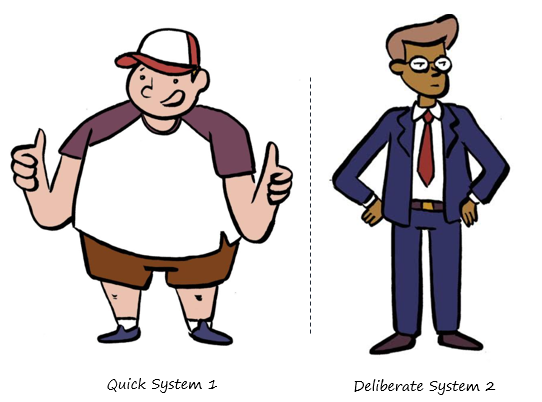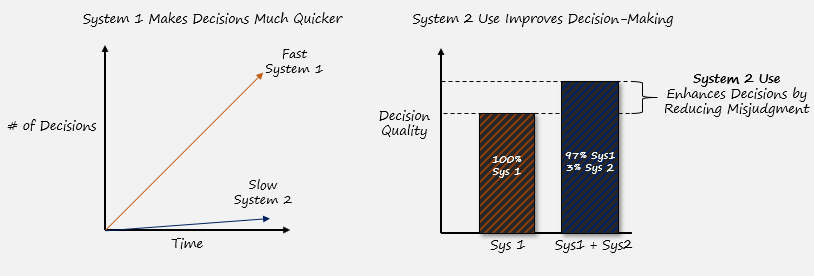System 1 and System 2 Thinking: How We Make Decisions
You might think we make all of our decisions the same way, but it turns out we have two very different decision-making systems.
Nobel Prize winning Psychologist Daniel Kahneman, in his book Thinking Fast and Thinking Slow, details the two cognitive processes for decision-making: fast System 1 and slow System 2.
These two cognitive systems work together to improve yoiur overall decision-making. At their best, they team up and aid you for making better decisions, by providing you with two different avenues from which to approach decision-making. When working together, this dynamic duo improves our overall decision-making.
For example: System 1, quick and instinctive, is perhaps like a short-sighted inner fat kid who might think, “OHH SHIT, queso and margaritas sound SOO GOOD rt now”—diets won’t be speaking this one’s language.
System 2, thoughtful and effortful, might weigh various trade-offs and say, “Hmm, I do have a leftover salad at home that I’ve already spent money on. Also, I have dinner plans later this week to eat out. Should I wait?”—the voice of reason (more or less)—though we don’t always listen.
Origins: System 1 and System 2
System 1 and System 2, originally named by Psychologists Keith Stanovich and Richard West, are metaphors for the two different ways in we make daily decisions. And fortunately, these depictions don’t require a PHD in neuroscience to be helpful.
In 2011, Daniel Kahneman helped bring to life and popularize System 1 and System 2 in his book, Thinking Fast and Thinking Slow.
Quick and intuitive decision-making is attributed to System 1 and lazy, effortful, and abstract decision-making to System 2.
When you’re driving a car or riding a bike trouble-free, that’s best represented as a System 1’s operation. When you’re working through long division, playing chess, questioning System 1, or learning to play the violin—these are tasks for System 2.
Syngergies: The Two Systems Team Up
System 1’s advantage in decision-making lays in its tremendous decision-making speed and output.
System 2’s advantage lays with complex problem solving like thinking through multiple possibilities, thinking in steps or ordering events.
(System 1 and System 2: Illustrative example of differences in decision-making)
In a normal day, your System 1 may handle 100 automatic decisions for every three effortful decisions your System 2 makes.
For example, driving a car requires you to make many decisions on the fly: reacting to other drivers, speeding up, slamming the breaks, avoiding potholes, etc. But deciding where you’re going to dine, which route to take or just how busy certain restaurants might be—that’s very System 2.
System 1 carries the heavy decision load, but it comes with a defect: it would rather conclude something than not conclude.
System 2 occasionally provides you with helpful skepticism at times when your System 1 could fall victim to rash thinking. Thus, your System 2 is better at withholding judgment and rethinking situations.
Ultimately, you utilize each system’s comparative advantage, in a way that the two systems synergize and so improve decision-making.
Examples from Thinking, Fast and Slow
For depicting the differences between System 1 and System 2 to the reader, Daniel Kahneman uses these two examples (among others):
A System 1 Question:
What’s 2+2 = ?
Here, the answer (4) should come to mind automatically. System 1 likely delivered it.
A System 2 Question:
What’s 17* 24 =?
Here, the math most likely gave you pause and required attention. The answer likely didn’t come to mind and you have to think on it. This math problem called on your System 2, which may have done something like this: 20*25, then removed 3*25, then removed a “17”—or some perhaps other math hack, though requiring multiple mental steps.
In another example, from Thinking Fast and Thinking Slow, Kahneman highlights flaws in judgment that are attributable to System 1:
“Participants in a much cited experiment read dozens of unfamiliar aphorisms such as:
Woes unite foes.
Little strokes will tumble great oaks.
A fault confessed is half redressed.Other students read some of the same proverbs transformed into nonrhyming versions:
Woes unite enemies.
Little strokes will tumble great trees.
A fault admitted is half redressed.The aphorisms were judged more insightful when they rhymed then when they did not. System 1 assigned more insight to the aphorism when it sounded better, despite the essence of the statement remaining the same.”
-Thinking Fast and Thinking Slow
According to Kahneman, rhymed wisdom has a comparative advantage in hearts and minds, relative to clunkier wording. Given System 1’s generous appraisal of rhyming wisdom, not to mention that rhymes go into cognitive storage much more easily, you might want to be careful with sing song wisdom.
Investing: Fast and Slow
If you’re thinking through retirement plans like 401Ks or IRAs, your System 1 may form some initial impressions while System 2 may offer you more thoughtful insights. Comparing both recommendations can improve your overall investment outcomes.
For those thinking about investing for retirement, via low-cost S&P 500 index funds, your System 1 might say:
“It feels like we should wait for the ‘perfect time’ to get in the market”
“Potential stock market losses loom large”
“With all the money in cash, it just sounds much safer”
“The recent market crash makes investing look like a bad idea”
“What if the market ‘went to 0’, and I lose the investments?”
After reflecting on the problem, your System 2 might raise the following refutations:
“Hmm, what are the odds you’d hit the ’perfect time’ anyways? ”
“Couldn’t stock market gains happen, too?”
“Where are all the ‘cash under the mattress’ retirees?”
“The recent crash, scary as it may be, looks like a more favorable entry point”
“If the US stock market, and all the major businesses, really ‘went to 0’ wouldn’t there be even bigger issues, anyways?”
Playing Sports: Fast and Slow
With sports, System 2 thinking has a bigger place in practice, while System 1 thinking is more for the games.
During practice, deliberately working through form, technique, plays, ball-grips and habit-forming drills, are all very System 2.
But if you're taking a game-winning 3-point shot with seconds left, trying for a walk-off homerun, or needing to lob a beautiful 40-yard touchdown pass on the game’s last play, this would not be the time for System 2’s to be thinking through technique.
Conclusion
Your System 1, intuitive and automatic, is a conclusion-making machine that smoothly navigates you through a fast-paced world. System 2’s greatest strengths are both its ability to think through step-by-step problems and also refute any of System 1’s hasty conclusions. Working together, this dynamic duo enhances your overall decision-making abilities.
For more information, Thinking Fast and Thinking Slow is a great book for those wishing to learn more about the distinctions between System 1 and System 2.
Further, much of Daniel Kahneman and Amos Tversky’s Nobel Prize winning work on structured errors (biases), associated with System 1, is detailed in the book. And a lot of their work was built upon often humorous and ingenious psychological experiments (perhaps an underrated part of their work).
Author’s Note
Have you ever solved the world’s problems when highway driving? Suddenly, you’re 15 miles down the road while System 2 was solving the world’s problems. System 1 drove those “unaccounted for” 15 miles.
Use questions, instead of statements, to engage someone else’s System 2. This helps improve conversation by reducing instinctual and superficial responses. Especially use open-ended questions that start with “How” or ”What”. They tell the other person you wish to hear what they have to say AND tend to generate better responses.
“How’s the project coming?” Vs ”Is the project done?”
“How’d the basketball game go? Vs “Did y’all win or lose?”

